Introduction: Towards a Soviet Empire
The Cold War began in 1947 as the prestige of the Red Army reached its Zenith, crushing the Nazi hordes during the “Great Patriotic War”, liberating eastern Europe, and promoting many pro-communist resistance movements across occupied Europe, partisans and networks of sympathies, voters and strong support even within the Western countries. USSR became an empire with an internationalist vocation, still under the fierce aegis of Stalin.
Now a permanent member of the United Nations, Soviet Union needed a fleet to match these new worldwide ambitions, in order to extend the revolution to the world. That force needed to keep the edge on each and every of these areas, Sevastopol, the Arctic (Murmansk, Polyarnyi), the Baltic (Kaliningrad), and the Pacific (Vladivostock, Petropavlovsk). A force capable of intervening throughout the world to support the emergence of communist regimes among the young nations resulting from decolonization.
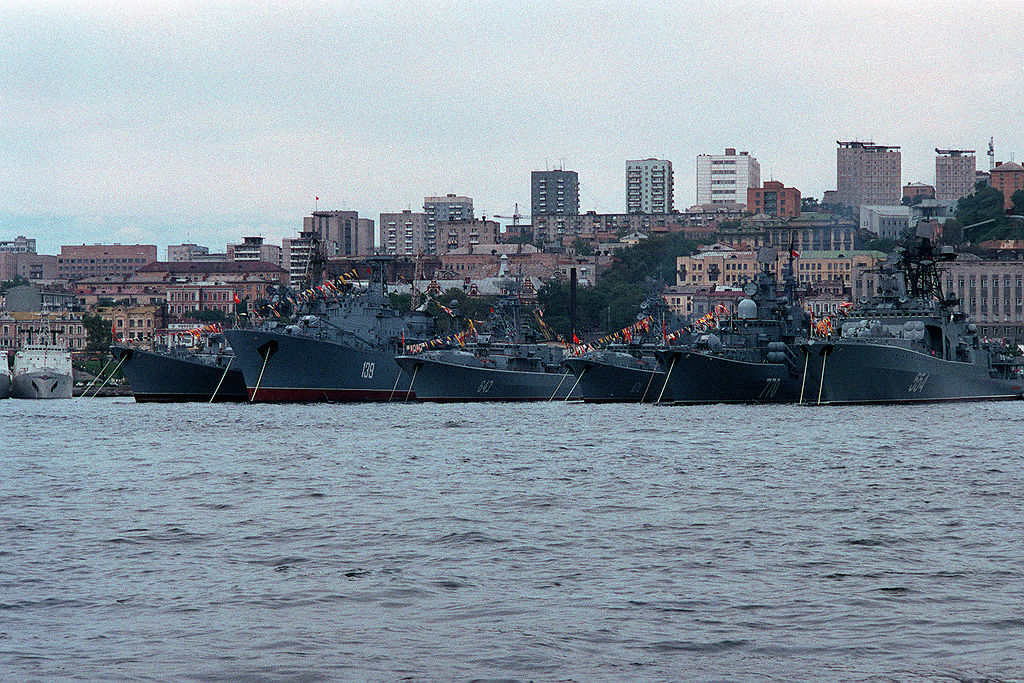
Soviet Pacific Navy in Vladivostok
First the Sovietskaya Flota SSSR had to counter the mighty US Navy, seen as the armed arm of capitalism which, added to the British and French fleets, disposed within the Atlantic alliance of an absolute naval supremacy. Its tactical choices would mainly be based on the will to conduct a “scientific” war, to extricate itself from the conventional schemes of the surface fleets, making extensive use of missiles in the design of new ships, but also in the use of specific long-range bombers (Bear, Badger, Blinder and Backfire – see chapter on Soviet Naval Aviation), numerous attack crafts and often unorthodox solutions to problems.
Articles published & to come
Done:
- A-90 Orlyonok
- Alfa class submarine (1969)
- Chapayev class cruisers
- Charlie class submarines
- Cold War Soviet Cruisers (1947-90)
- Cold War Soviet Destroyers
- Cold War Soviet Submarines
- Delta I class submarines (1970)
- Delta II class SSBNs (1972)
- Delta III class submarines
- Delta IV class submarines
- Echo I class submarines
- Echo II class submarines
- Foxtrot class submarines (1957)
- Golf class submarines (1957)
- Grisha class Corvettes (1977)
- Hotel class submarines (1959)
- Juliett class SSG
- Kara class cruisers (1969)
- Kashin class destroyers (1964)
- Kiev Class (1972-82)
- Kilo class submarine (1980)
- Kirov class Battlecruisers (1977)
- Kola class frigates (1951)
- Komar class FACs (1960)
- Koni class Frigate (1975)
- Kotlin class destroyers (1958)
- Kresta I class cruisers (1964)
- Kresta II class cruisers (1968-76)
- Krivak class frigates (1970)
- Krupny and Kanin class Destroyers (1959)
- Kuznetsov class aircraft carrier (1985-88)
- Kynda class cruisers (1961-63)
- Mirka class Frigates (1960)
- Moskva class Helicopter Cruisers (1965-68)
- Neustrashimy, Proyekt 41 destroyers
- November class Submarines (1957)
- Petya class Frigates (1960)
- Poti class Corvettes (1960)
- Quebec class submarines (1950)
- Riga class Frigates (1952)
- Romeo class submarines
- Sierra class submarine
- Skory class destroyers (1949)
- Slava class cruisers (1979-90)
- Soviet Frigates
- Soviet Missile Corvettes
- Sovremenny class destroyers (1978)
- Sverdlov class cruisers
- Tango class submarines (1972)
To Do:
- Project Anchar DDN (1988)
- Koni class (1976)
- Neustrashimy class (1988)
- Nanuchka class (1968)
- Pauk class (1978)
- Tarantul class (1981)
- Dergach class (1987)
- Svetlyak class (1989)
- Alfa class submarine (1969)
- Delta I class submarines (1970)
- Delta II class SSBNs (1972)
- Delta III class submarines
- Delta IV class submarines
- Echo I class submarines
- Echo II class submarines
- Foxtrot class submarines (1957)
- Golf class submarines (1957)
- Hotel class submarines (1959)
- Juliett class SSG
- Kilo class submarine (1980)
- November class Submarines (1957)
- Quebec class submarines (1950)
- Romeo class submarines
- Sierra class submarine
- Tango class submarines (1972)
- Typhoon class submarines
- Victor I class submarine (1965)
- VICTOR II class submarine (1972)
- VICTOR III class submarine (1977)
- Whiskey class submarines
- Yankee class submarines (1965)
- Zulu class submarines (1952)
- Papa SSGN (1968)
- Oscar SSGN (1980)
- Sierra SSN (1982)
- Mike SSN (1983)
- Akula SSN (1984)
- Kilo SSK (1986)
- P2 class FACs
- P4 class FACs
- P6 class FACs
- P8 class FACs
- P10 class FACs
- Project 184 FACs
- OSA class FACs
- Shershen class FACs
- Mol class FACs
- Turya class HFL
- Matka class HFL
- Pchela class FACs
- Sarancha class HFL
- Babochka class HFL
- Mukha class HFL
- Muravey class HFL
- MO-V sub-chasers
- MO-VI sub-chasers
- Stenka class sub-chasers
- kronstadt class PBs
- SO-I class PBs
- Poluchat class PBs
- Zhuk clas PBs
- MO-105 sub-chasers
- Project 191 River Gunboats
- Shmel class river GB
- Yaz class river GB
- Piyavka class river GB
- Vosh class river GB
- Saygak class river GB
- T43 class
- T58 class
- Yurka class
- Gorya class
- T301 class
- Project 255 class
- Sasha class
- Vanya class
- Zhenya class
- Almaz class
- Sonya class
- TR40 class
- K8 class
- Yevgenya class
- Olya class
- Lida class
- Andryusha class
- Ilyusha class
- Alesha class
- Rybak class
- Baltika class
- SChS-150 class
- Project 696 class
- MP 2 class
- MP 4 class
- MP 6 class
- MP 8 class
- MP 10 class
- Polocny class
- Ropucha class
- Alligator class
- Ivan Rogov class
- Aist class HVC
- Pomornik class HVC
- Gus class HVC
- T-4 class LC
- Ondatra class LC
- Lebed class HVC
- Tsaplya class HVC
- Utenov class
- Kamov Ka-10 Hat
- Kamov Ka-15 Hen
- Kamov Ka-18 Hog
- Kamov Ka-25 Hormone
- Kamov Ka-27 Helix
- Mil Mi-8 Hip
- Mil Mi-14 H?
- Mil Mi-4 Hound
- Yakovlev Yak-38
- Sukhoi Su-17
- Sukhoi Su-24
- Ilyushin Il-28 Beagle
- Myasishchev M-4 Bison
- Tupolev Tu-14 Bosun
- Tupolev Tu-142
- Ilyushin Il-38
- Tupolev Tu-16
- Antonov An-12
- Tupolev Tu-22
- Tupolev Tu-95
- Tupolev Tu-22M
- Tupolev Tu-16
- Tupolev Tu-22
- Beriev Be-6 Madge
- Beriev Be-10 Mallow
- Beriev Be-12
- Lun class Ekranoplanes
Soviet MTBs/PBs/FACs
Patrol boats/Sub Hunters
Gunboats
Minesweepers
Amphibious ships
Naval Aviation
Soviet Naval Air Force
1940s naval plans
For all these reasons, and thanks to a colossal budget, the Russian navy was to emerge from its ashes in 1917, and after the naval rearmament plan of 1937, the third five-year plan, launched a new one, which began in 1946. It was largely based on the 1936 plan unfinished because of the war.
Cruisers of the Chapayev and Sverdlov classes, Skoriy class destroyers, Whiskey class submarines (all NATO code names), would be the first postwar class to match these ambitions and maintain its conventional strength until the 1960s. Besides, Stalin was willing to endow the USSR with 24 battleships and battlecruisers, 20 cruisers, 350 submersibles, but this plan was never approved. A new plan was prepared for the period from 1938-1947, this time comprising 50 battleships, 35 cruisers, 607 destroyers and minesweepers, frigates, 336 submarines and 348 torpedo boats, but also two aircraft carriers.
Nor was it approved, which was later reduced to its simplest form. The final five-year plan of 1938-42 included 6 battleships, 2 aircraft carriers, 4 heavy and 17 light cruisers, 12 heavy destroyers, 197 submersibles and 271 smaller ships. Part of this plan was realized: destroyers, subs, cruisers made it out of the shipyards, but neither the battleships of the Sovietski Soyuz class nor the battlecruisers of the Kronstadt class, nor any aircraft carriers were ever completed.
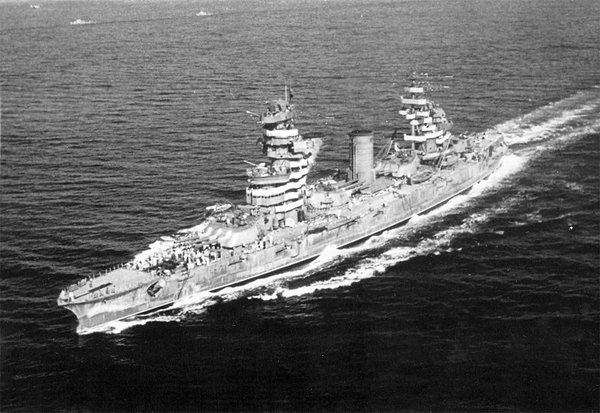
Battleship Sevastopol after the war. Two of the class would served until the late 1950s, only because the West maintained a few battleships in active service, like the Iowa class, Vanguard, and Jean Bart.
The Soviet Navy State in 1945
USSR emerged as a winner from WW2 with the largest tank force, the second largest air force, but a fleet that was scattered and reduced to light vessels for the most. The bulk of it was indeed sunk of captured in 1941 and 1942. The remainder counted mostly submarines and gunboats, with the exception of dozens of destroyers still active in the Baltic and black sea, and soon two elderly battleship and a few cruisers. All major construction were put at end with the invasion, and designs were froze for after V-day.
When this came, Stalin ordered a new naval plan, actively bringing up a conventional -if not retrograde in some ways- of the fleet, forcefully advocating and pushing for battleships and heavy cruisers whereas the type has been severely undermined by air warfare. The same vision applied to tanks and in particular heavy tanks, soon to be obsolete because of the adoption of much greater guns on lighter, more agile MBTs. After Stalin’s death, all construction plans for new battleships and “battlecruisers” were cancelled.
Wisely, Khrushchev relied on the vision of visionary Admiral Kuznetsov, that previously argued hopelessly against Stalin on both the battleships and heavy cruisers program and promoted instead construction of missile-armed specialized ships able to accurately take out the American aircraft carriers from a safe distance. For Stalin these large warships were chielfy, very much like Hitler saw these, a matter of prestige. And also like the master of the third Reich he was little interested by naval matters or the sea as a whole.
Admiral Kuznetsov”s reforms
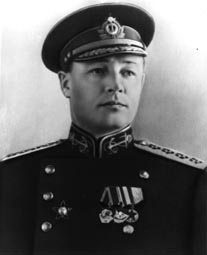 There’s nothing odd about Admiral Kusnetzov being honored in a modern Russian aircraft carrier, as the man’s career changed the Soviet Navy and made it realistic and an efficient force. He was soon placed at the head of the navy, making deep cuts into Stalin’s program, favoring light units.
There’s nothing odd about Admiral Kusnetzov being honored in a modern Russian aircraft carrier, as the man’s career changed the Soviet Navy and made it realistic and an efficient force. He was soon placed at the head of the navy, making deep cuts into Stalin’s program, favoring light units.
The second plan of 1943-47, on which expectations for heavy units were all but gone, never came to light because of the spectacular advance of the Wehrmacht after the outbreak of Barbarossa.
Priority was given to land and air forces. However, in 1945, if most of the major shipyards in the west had been devastated by the war, the advance of the Red troops had resulted in the taking of many shipyards in East Germany, including Schichau in Elbing, Königsberg (Renamed Kaliningrad), and especially the factories where the revolutionary U-Boote type XXI was produced. This also included German laboratories and arsenals where engineers were preparing and experimenting with a number of anti-ship missiles and very advanced propulsive techniques such as hydrofoils, sound-seeking torpedoes, radars and sonars.
In 1945, work was begun on modified versions of the 1938-42 plan (1946-50 plan, including the Stalingrad class vessels), and work on a completely new definition of the fleet, Based mainly on long-range missiles, and in accordance with the industrial means of the USSR at that time. (Plan 1956-60).
The first was to be continued for 10 years and included 4 “super cruisers” (Stalingrad), 10 heavy cruisers, 30 medium and 54 light aircraft, 6 large aircraft carriers and 6 light aircraft, 132 heavy and 226 light destroyers, 495 submarines, and 600 other units. The new plan of 1960 incorporated the first units that take into account nuclear power, both for propulsion and armaments, and which still change the situation, which justifies the choice of this date to stop a long period, that of the The last “classic” Soviet fleet.
For submarines, whereas the USA focused in the latter period (post-1960) on SSN and SSBN alone, on the other side of the Atlantic, there were at least six types operating, declination of the standard attack type, missile hunter, and deterrent launcher.
-SSN: Nuclear Attack Submarine
-SA: Attack Submarines
-SSG: Attack Submarine (Missile)
-SSBN: Nuclear Ballistic Submarine
-SSGN: Nuclear Attack Submarine (Missile)
-SSB: Ballistic Submarines (Diesel)
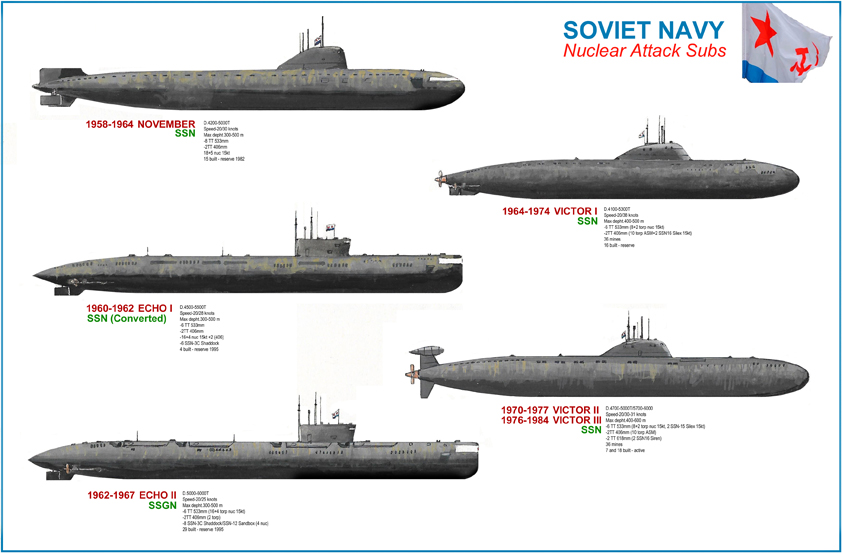
Soviet SNA classes (early)
The Soviet Navy in 1960
In this era, the Soviet Navy inherited from the 1938-42, 43-47 (largely abandoned), 46-50 and 50-56 plans. In 1945, its tonnage was relatively large, although very far from the US Navy and the Royal Navy. This conventional fleet was composed of guns armed cruisers, destroyer and diesel attack submarines, but ranked third, taking the place occupied by the Japanese fleet in 1941.
Battleships:
The fleet still had the two very old surviving units of the Marat class (1911), which, although modernized, by no means equalled the standards imposed by post-war naval strategy. The Oktabrskaya Revolutsiya and the Sevastopol, which had been retired from service in 1950 and 1954, still existed afloat in 1958. Following the Lend-lease agreement, Great Britain transferred to the USSR the battleship Arkhangelsk (former Royal Sovereign, Resolution, 1915), which returned to its first owners in 1948, and following the war damage granted in 1946, she operated until 1955 the battleship Novorossiysk, ex-Italian Guilio Cesare (1911).
Of very limited military value because of their outdated design, these ships made it difficult to overcome the absence of the heavy units provided for in the 1938 and 1943 plans: Battleships of the Sovietskiy Soyuz class: These three units, which were put on hold in 1938 and 1939 under the first plan, remained unfinished because of the hostilities. The hulls were demolished in the 1940s. Battle cruisers of the Kronstadt class: Begun in 1939, they were hardly more advanced.
1943-47 plan revised 1950-56 plan project: Three major battlecruisers of the Stalingrad class, begun in 1951, 52 and 55, should have been completed in 1954-58 if it was not for the death of Joseph Stalin. They would certainly have been surpassed by the supremacy of the missiles, which prompted their cancellation by Admiral Kusnetsov just after Stalin’s death for which they were merely ships of prestige.
-Cruisers:
In 1945 the fleet consisted of 8 cruisers, starting with the old Profintern and Krasnyi Kavkaz, and the more modern Kirov and Gorky classes. Under construction since 1938-39, the Chapayev class never has been completed in time before the hostilities and eventually entered service between 1949 and 1950 after some alterations. These 5 units of the 1938-43 plan served until 1960-61. They were followed by the Sverdlov class, 14 units launched between 1950 and 1955.
In 1942-45 the USSR briefly operated the Tallin, formerly Lützow, transferred by Hitler to Stalin under the non-aggression pact. The Tallinn, never completed and used as a floating AA battery, was broken up in 1958. The Murmansk was the former USS Milwaukee of the Omaha class (1922), transferred, entering service in 1944 and returned to its owners in 1949, as well as the ex-Italian cruiser Duca d’Aosta, under the name of Kerch.
-Destroyers:
Most units of the 1936 plan, those of the Gnevnyi class, and the heavy destroyers of the Leningrad class, were lost during the conflict. The surviving units in 1945 were less than twenty (see Soviet fleet 1939-45).
The 14 units of the Ognevoi class, completed for two of them in 1944-45 and 1945-49 for the others, were in service in 1960, so they were part of the fleet at that date, Design dates back to 1936. Above all, the 51 destroyers of the Skoryi class (1949-52) were commissioned, a traditional conception inherited from the Ognevoi.
They were followed by a new generation Flush-deck hull, the 32 Kotlin, preceded by the prototype Neutrashimmy. The Kotlin entered service between 1955 and 1958, and were subsequently extensively modernized, including missile-launcher conversions the Kildin class.
Finally, those of the Krupny class, followed in 1959-60. These 8 units were the first missile destroyers designed as such in the USSR. However, they are not included in the tonnage studied here because they entered service during 1960-62.
Neutrashimyy class destroyers
This great “fush deck” hull destroyer is the ultimate development of the classic destroyer as it was defined before the Great War. It was not the last, but prefigured the Kotlin class to which it served as a prototype. The Neutrashimmy basically took over everything that existed on the Skoriy, married on a new hull.

Author’s illustration of the Neutrashimyy
Specifications
Displacement: 6500t, 7500t
Dimensions: 164.93 x 17.22 x 5.03m
Propulsion: 4 Parsons turbines, 4 Yarrow boilers, 54,000 hp. and 30 kots
Armour: Decks and turrets 51 mm, belt 76.2 mm
Crew: 556 + 60 cadets
Armament: 9 x 152mm (3×3) guns, 4 x 102mm guns, 8 AA 40mm Bofors, 6 x 533mm TTs (2×3) guns
Specifications
Déplacement & Dimensions 6500 t, 7500 t PC – 164.93 x 17.22 x 5.03 m
Propulsion 4 turbines Parsons, 4 chaudières Yarrow, 54 000 cv. Et 30 Noeuds max.
Blindage: Pont et tourelles 51 mm, ceinture 76.2 mm
Equipage 556 + 60 cadets
Armement 9 canons de 152 mm (3 x 3), 4 canons de 102 mm, 8 canons AA 40 mm Bofors, 6 TLT 533 mm (2 x 3)
-Frigates:
In 1945, there were still 13 ships of the Uragan class (1929-35), 450 tons, but arrived at the end of their active career in 1958, and were struck the following year. The ten most powerful (900 tons) and newer (1940-41) Yastrebs, and all but the Yastreb herself, were in service in 1960, and withdrawn in 1963-66. The first class of the postwar period was very inspired by the 1939 German torpedo boats, with flush deck hulls. The Russians resumed this design and their style “destroyers”.
These eight ships of the Kola class were put into service in 1952-54. They were followed by the Riga class (1955-59), 68 ships, a little smaller. However, before 1960, 8 units were transferred to Bulgaria, East Germany and Finland.
-Submarines:
The impressive fleet of submersibles from the Second World War was still partly in service in 1960, and included in 1945 the coastal M and V classes (90 units), the medium Shch (76 units), the oceanic type L, Those of the S series (33) and K series (14). All were very classical in design, dating back from the 1930s. They were obviously overwhelmed by the new submarines from the U-boote type XXI. In 1960, 75 coastal submersibles, 13 mediums and 43 oceanic submarines remained in service. Their replacement was conditional on the effective commissioning of the new generations of Russian submarines, the Whiskey class (‘W’ code-named NATO), built at a rate of 215 between 1951 and 1958.
They were followed by The ‘Zulu’ class, with 18 units, long range ocean variants of the first. They were built between 1952 and 1955. A new class appeared in 1957, the ‘Romeo’ class, an upgraded version of the Whiskey, a total of 21 of which will be built, including 5 in service in 1960. Finally, the ‘Quebec’ class, 30 coastal units built between 1950 and 1958.
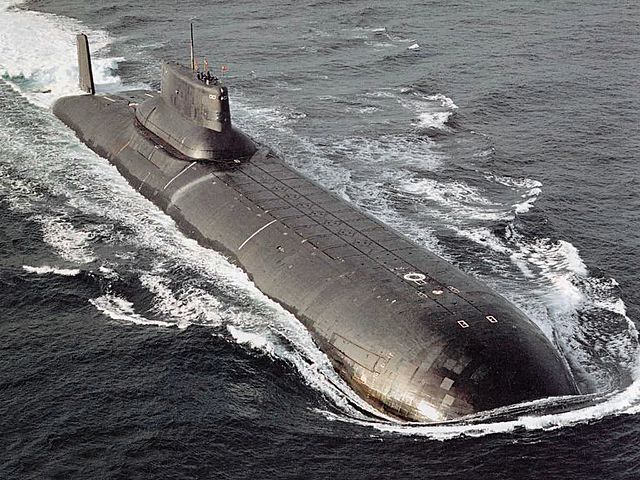
Typhoon class submarines (SSBN), the largest ever built.
All of these units had conventional powerplants, with an emphasis on electrical power to produced between 13 and 16 knots underwater, which was much better than the average performance of previous generations (7-9 knots), but still Limited to Walter propulsion systems. The first Russian submarine to fully benefit from the research of German engineers in 1942-45 was the S-99, ‘Whale’ for NATO, launched in 1952 after many modifications, and based on the U-Boats type XXVI, successors Of the XXIs which existed only on paper. There were many problems with this project.
Nevertheless, she made 98 sorties until 1959, showing that the Walter turbine was able to give a speed of 22 knots underwater in a reliable and routinely manner. She was the victim of an explosion due to overpressure at 80 m depth. She was later refloated but never repaired. Project 643, larger, was never completed nor tested. Nuclear power made these attempts at closed loop engines now obsolete.
-Miscellaneous
In 1945, the Russian fleet had 400 torpedo crafts and gunboats, including “lend-lease” units of American origin (Elco, Higgins, etc …). All were retired from service before 1960, to make room for new Komar class Fast attack crafts (missile). It should be noted that in 1960, the Soviets still had 90 torpedo boats of the ‘P2’ class (1944-46 and 1947-52), 349 of the ‘P4’ class (1947-52), inspired by the ‘Higgins’ for the former. There were also in service 63 submarine hunters designed on the same hull, type MO-V class (1948-52).
They were followed in 1951-55 by the 622 units of types P6, P8 and P10, very similar, but largely redistributed to the friendly countries and satellites before 1960. So of this total there were only 513 in service, Of which 60 were converted into target ships, others into test hydrofoils. There were 60 submarine-based MO-VIs, and Komar missile launchers, numbering 112. North Korea and China, in addition to the transfers operated in the 1960s built hundreds under license.

Soviet P4 class boats. 349 has been built, in wood, partly on Higgins boat plans until 1952.
There were also minesweepers of the Tral class (1935-40), of which eight had been sent to North Korea in 1955, the remaining 12 would be removed from the lists before 1960, and 14 from the Polukhin class (1940). USSR also used American and British lend-lease ships, the 33 “Admirable” class, and the 14 MMS class (British), as well as 43 units of the YMS class, all broken up before 1956. But the best of this fleet consisted of ex-German ships, captures and war damages, namely 60 minesweepers of the M35, M40 And M43 classes.
They were studied extensively to build a new proper class, the T43 (178 units built between 1947 and 1957) and the T58, much larger, and whose first series of 30 units was just being commissioned in 1960. Also were ordered in Poland at Gdansk, Poland, the construction of two lightweight coastal minesweepers classes, those of TR40 (1957-59) and K8 (1954-59), at the rate of 55 and 130 units.
The Russian Navy was always of considerable importance and the new constructions were numerous. These were the patrol ships of the Kronstadt class (157 ships in all, dating from 1950-55, but 53 of which will go to friendly countries before 1960). They were followed by those of class SO-I, whose construction began in 1957 and ended in 1968. The series had 12 units, but there were only a handful in service in 1960. The KGB ordered 34 patrol boats of the Poluchat I class from 1955 onwards, the last of which entered service in 1957, two submarine fighters MO105 and 106, and 119 inland gunboats of the BK class (1947-50).

In 1960, the fleet was in a state of turmoil: the first nuclear submarines appeared, the “November”, which would have great difficulty in proving their reliability. Then, quickly, the possibility of using medium and short range nuclear vectors will led to the adaptation of conventional submarines, the “Hotel”. The first real SSVN appeared in 1968: The “Yankee”, followed by the long line of “Delta” which ends with the series of gigantic “Typhoon”. But by 1960 the navy counted 19 cruisers, 98 destroyers, 400 submarines and 2218 miscellaneous ships.
A technological powerhouse
Of the three military branches, the Navy would be the one which will receive arguably the greatest attention and largest funds, for two main reasons: The development of a defensive force large enough to defeat the US Navy, in three geographical areas. Second, to deter with a powerful ballistic submarine fleet and ways to neutralize enemy’s own forces. In the latter phase, the Soviet fleet also developed an amphibious fleet capable of worldwide deployment, although not in the scale of the US Navy. USSR long had a clear advantage in submarines, mass-building reliable diesel attack submarines using late ww2 German designs, and launching back in 1960 the fastest nuclear attack sub in the world, the November class.
Although it was also the first toying with the idea of ballistic missiles carried by submarines, the Soviet Navy also developed its very own solution against the large aircraft carriers: Nuclear attack submarines launching powerful cruise tactical missiles (SSGN). A tradition that started with the Juliet and stopped with the massive Kursk type. USSR also embarked in sophisticated propulsion system like the one fitted in the Alfa serie, again the fastest and deepest diving, most futuristic SNA design of their day.
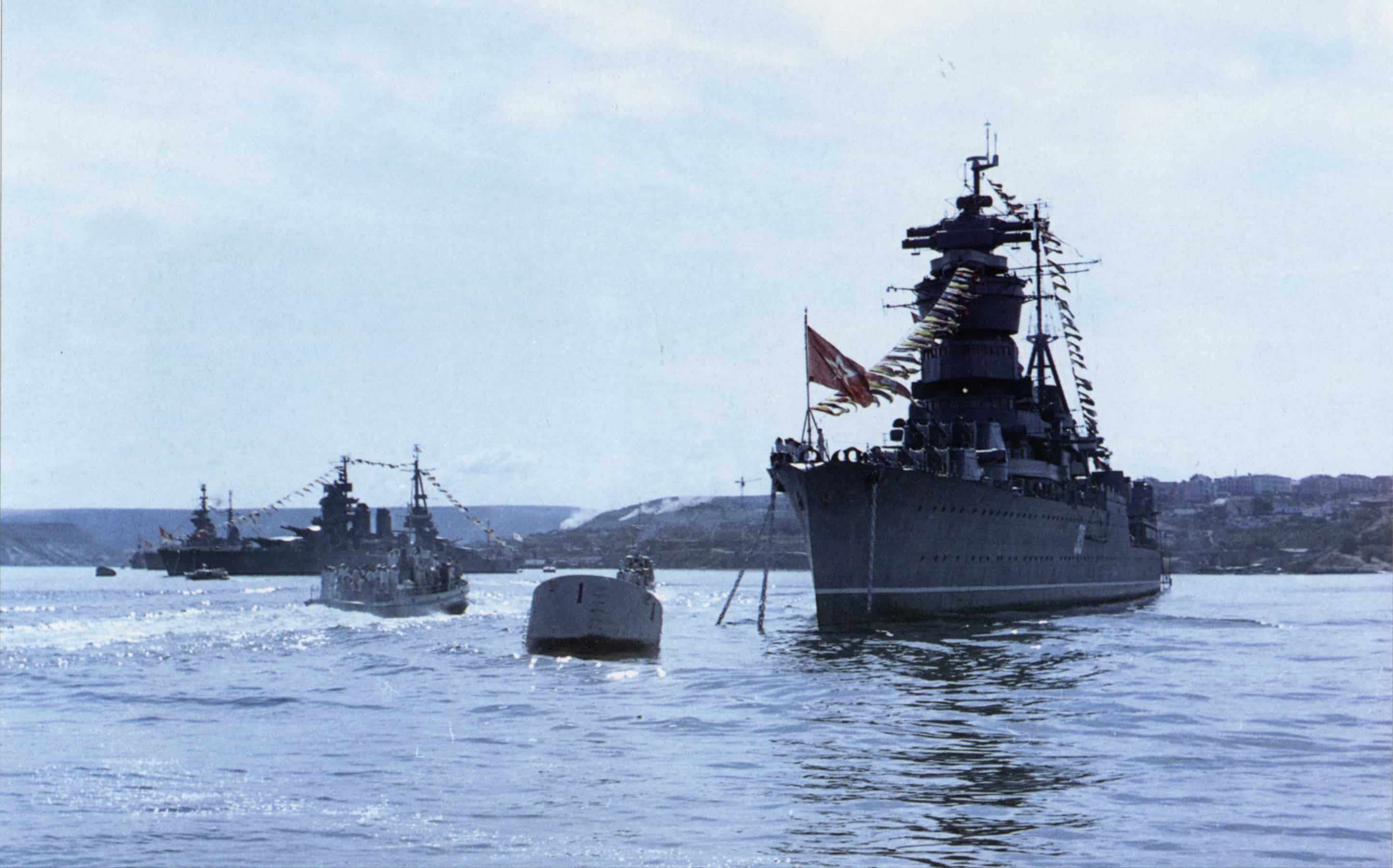
Cruiser Kuybyshev at Sevastopol, 25 july 1954.
Other daring attempts towards unconventional solutions can be found either with the attack hydropters, assault hovercrafts, and ekranoplanes, probably the strangest-looking and most impressive assets in their arsenal. In many ways, the Soviet navy power was seen by many expert equal in a sense that it could bring some balance towards equity, but it was nowhere near as homogeneous and conservative as the US Navy, centered around its giant task forces.
At first glance it seems the Soviet brains experimented a lot, which left quantites of small series of ships, with incremental progresses, and some hybrids, like the Moskva, Kiev and even the Kuznetsov. The Kirov were missile cruisers of such firepower they had been dubbed as a reboot of the battleship concept in the 1980s and motivated on the US side, the costly modernization of four ww2 veterans of the Iowa class.
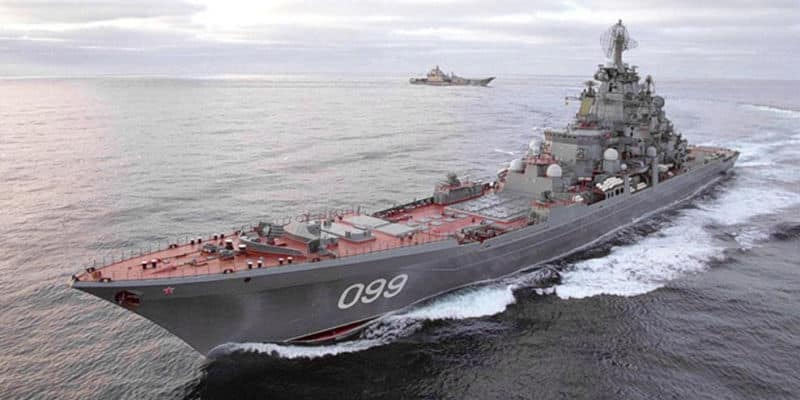
In terms of air support, deterrence, long range strike, close range defense against missiles, incoming planes or ASW capabilities, the Soviet Navy was fully equipped and well trained. This formidable force however was not to last. Because of the lack of funds and state of disrepair the fleet fall to a state of neglect which traduced eventually in a collection of hulks cannibalized to maintain a few ships in the 1990s. With the revival of Russian military power however and a new size more in par with a much reduced budget, the Russian Navy strengths of tomorrow still largely relies on these cold war assets and new ambitions, as shown by the impressive Lider nuclear-powered class super destroyers.

“Whiskey” class submarines
Naval doctrine & Strategy 1947-1970.
The Soviet fleet underwent a major upheaval from 1960 on. At that time, as for the USA, the “classic” navy gave way to much more costly missile launcher units. The Soviet Union then acquired a formidable high seas fleet, an important part of its great military power during the Cold War. The transition is very concrete: Indeed, its first nuclear-powered submarines, the “November”, take office in 1960-64. The missile launchers of the Kynda class in 1962-64, the Krupny missile destroyers in 1960-61, the first SNLE (Hotel and Golf) in 1960-64 and the first SNA missile launchers (Echo) in 1960-61, 63…
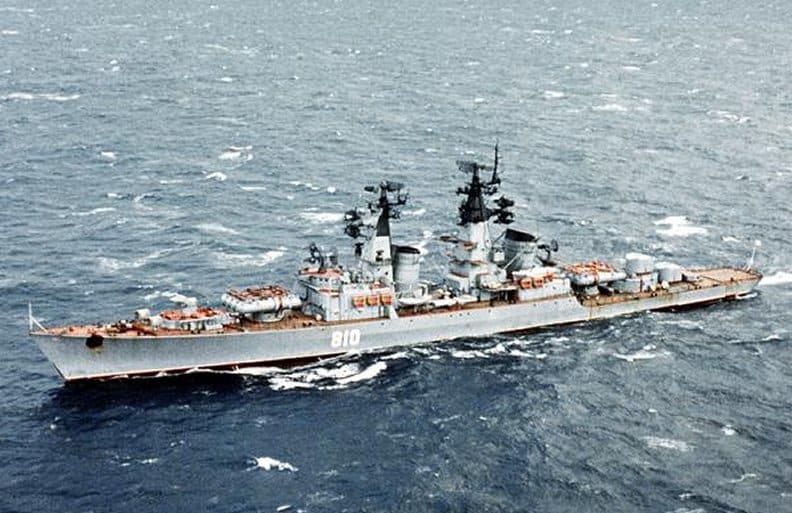
After the post-1945 decade, including a design conflict at the top of the fleet command, between Stalin and Admiral Kusnetsov. The latter was in favor of a modern and measured fleet destined to fight against the US Navy and help (later) to intervene between the counterrevolutionary forces (supported by the Westerners) and the new people’s democracies born of decolonization .
Stalin, on the other hand, had remained essentially in the principles of the naval war of the 1930s, with an absolute primacy given to gunnery, in order to seek the “decisive shock” on the high seas. He did not understand the new role of the carrier and granted it only a reduced utility, nor to the new developments arising from the labors of the German engineers, concerning the missiles and submarines at Schnorchel.
After his death in 1954, Kusnetsov was going to have his hands free to develop his plan to modernize the Russian Navy. The first results will not appear until 1960. From that date, Kusnetsov and his successors will not cease to deploy an ever more impressive arsenal of missile-launching ships in order to counter the Us Navy and particularly intended to strike Its aircraft carriers, but also to ensure the defense of its SNLE, guaranteeing its deterrence.
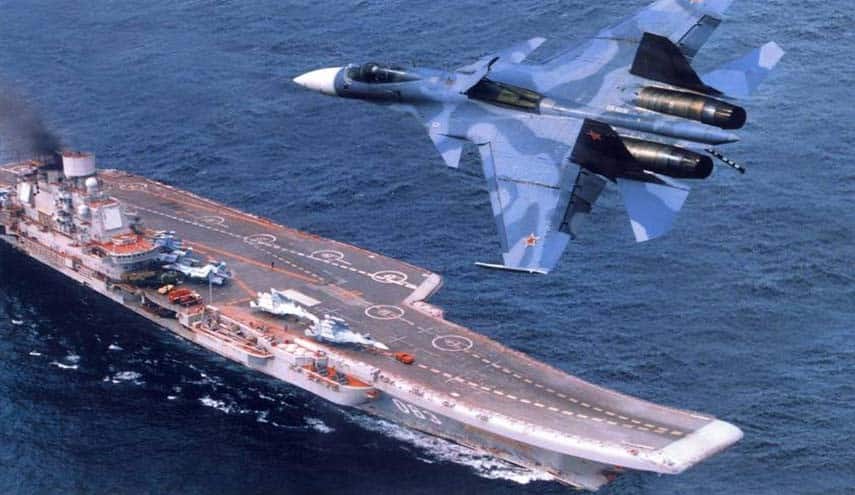
The Soviet navy will develop its efforts in the field of anti-ship-to-shore combat, resolutely focusing its strategy on long-range missiles, designing submarines for this purpose, and its surface units. Moreover, the specialization of the units was patent, unlike the Americans. Thus, the four Kynda were deliberately designed to sink American aircraft carriers, as well as the Echo Class SSGNs, and their successors Charlie and Oscar. They will therefore design generations of anti-ship missiles with long range and heavy (nuclear) load.
They will also design unique units such as the ‘Typhoon’ class submarines, the largest submarines ever built (more than 25,000 tons submerged), the largest SSNs (Oscar II, 16,000 tons) The fastest (Alfa, 45 knots), the largest missile cruisers of all time (Kirov, 250 meters and 30,000 tons) as well as hybrid aircraft carriers (Kiev) and helicopter carriers (Moskva), even in some extent the actual Kuznetsov design in partly hybridized with a missile cruiser.
This high-seas fleet is also complemented by an amphibious fleet, which, although still far below US capacity, is still the second largest force in the world, including the use of unusual ships such as hovercrafts , Including the enormous Pomornik. Finally, Soviet “coastal” naval force will remain very offensive thanks to a collection of missile launches successfully exported (class Osa I and II), and large numbers of combat hydrofoils, type of ship they will be the only ones to develop this way with the Chinese, legacies of coastal defense concepts born before the war. Other avant-garde solutions are concerned, such as Ekranoplanes.
Finally, their naval aviation will be able to count among its ranks excellent bombers, such as the robust TU-142 “Bear” turboprops with counter-rotating propellers, equivalent of the Convair Peacemeaker in their time, or the “Badger”, “Blinder” As well as the remarkable “Backfire” wings with variable geometry.
Soviet Navy order of battle, 1991
Soviet Aircraft Carrier: 7
The most powerful units of the Soviet fleet were strange hybrids not really deserving the name “aircraft carrier” in the traditional western sense, referring instead to the hybrids built out of battle cruisers and other battleships back in 1918-1922. In any case, before the Kusnetsov and the Varyag, they are not comparable to the huge US aircraft carriers.

Kiev class aircraft carrier/cruisers
These were the two Moskva class helicopter cruisers (1965 and 1968), in front of the cruiser, and the four Kiev (1972-82), which are ASM cruisers on their front deck, and then aircraft carriers, With cruiser superstructures offset on the edge. All six were in service in 1990. At that time, aircraft carrier Admiral Kuznetzov, launched in December 1985, was about to begin testing in January 1991.
This is the first “pure” ship of this type Built in the USSR, equipped with combat aircraft with military capabilities equal to that of the US Navy’s embedded forces. Indeed, units of the Kiev class were not able to operate other types of aircraft than VSTOL (ADAC) Yak-38 FORGER, mediocre copies of British Harriers and AV8 Americans.
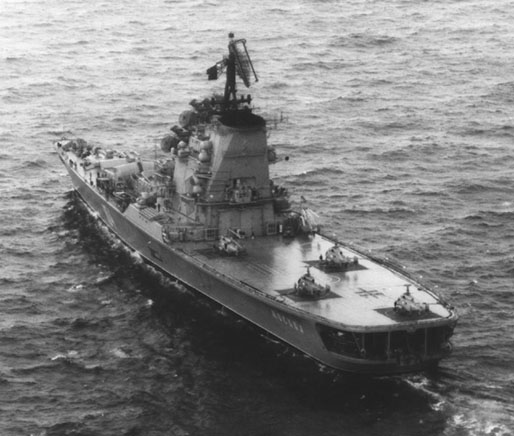
Moskva class helicopter cruisers
The second aircraft carrier of the class, the Varyag, remained incomplete, in fact it lacked only the electronics, sensors and embarked armament. At the end of 1991, the Russian Government declared that it could no longer release the $522 million needed on its completion and was transferred to Ukraine awaiting uncertain fate and possibly to be resold, and failing that, Scrapped. In the end it was purchased by an Asiatic third-party to be converted as a “floating casino” and then ship to Dalian. It would be later completed as the first Chinese aircraft carrier, the Liaoning.
New aircraft carriers, Nimitz style has been considered: The Ulyanovsk or Project Orel was a paper project for an aircraft carrier displacing 80,000 tons equipped with catapults and abandoned in 1975). These ships should reach 280 meters at the level of the flight deck (which was flat, and not raised at the end). The first unit was laid on hold in 1988, and construction stopped abruptly in 1991 following the coup. The hull was later broken up.
Soviet Cruisers: 35
Battleships were all but eliminated as well as large cruisers, after Stalin’s death. Not quite, some units of the Russian fleet deserve to be included as “neo-battleships” although they are not armoured: These are the Kirov, an overkill in terms of missile cruisers. The first missile cruisers, whose potential therefore relies mainly on these vectors and not artillery, were the Kynda class. These four ships had been equipped with two massive mobile ramps on both ends, for powerful anti-ship missiles (8 ready for launch and 8 in reserve) and were evidently designed to destroy US aircraft carrier task forces at long range. It is true that at the time, the means of detecting and destroying a missile in full flight was still a delicate matter.
Subsequently, it was the four Kresta I class that followed in 1965-67, with a larger anti-aircraft armament (2 SA-N 1). These were considered indeed like AA cruisers. The ten Kresta II (1968-76) were redefined during construction as ASWM cruisers. The 7 Kara (1969-76) were a good compromise, combining ASW, anti-ship and anti-aircraft capabilities. The 4 Kirov (the first one launched in 1977, the others in 1981, 86, and 89) were not only monsters in their category (justifying a costly modernization and active service for the four mothballed Iowa class during the Reagan administration).
ut the Kirov class also inaugurated a nuclear propulsion, rare for this type of surface ships and so far only featured by the USS Long Beach. This had consequent advantages, as an hybrid propulsion composed of high pressure boilers and two reactors. These were symbolic of this period of “cooling” in relations between the two greats.
These were also the last Soviet cruisers. Next to these appeared the designated successor of the Kynda, the imposing Slava. These hybrid vessels (1979-90) were identified by their fixed ramps of SS-N 12 (4 doubles launchers), and also anti-aircraft missiles silos, as for the Kirov.
Of the four units built, three were in service in 1990. Two went to Ukraine in 1990 and 1995. Oldest were the conventional Sverdlov class cruisers still in service, two being converted into hybrid missile launchers, Zhdanov and Senyavin, the other two serving as school ships.
Soviet Destroyers: 53
There were only two classes of destroyers from 1960 onwards, the Krupny (8 units), 1960-61, and the Kashin (19). The latter would be built and launched from 1963 to 1972. All these units received additional armaments, including anti-ship missiles in lateral ramps, a helicopter runway and additional fast-launch missile guns. Not all remained in service in 1990, only 4 Krupny, and 17 Kashin.
It is a fact that no destroyer was built since then, but the “cruisers” of the Udaloy and Sovremenny classes that later would be considered as large destroyers. Also in service were some units of the modified Kotlin class, converted in ASW or anti-aircraft units, receiving various types of missiles and sometimes helicopter runways of the Kildin sub-class. All classic destroyers of the Skoryi series of the Fifties had been widely exported and the remainder were disarmed in the years 70-80.

Although for a time classed as cruisers, the last and most modern were the sips of the Sovremenny class or Project 956 Sarych (Buzzard). (officially successors of the “Kresta”), they had been built in a long serie from 1976 to 1998, with the the last of these 19 vessels (twelve by 1990). Besides, the “Udaloy” (1980), ships supposed to replace the Kara but designed to match the American “Spruance” class were also built. There were a series of 14 ships, the last being received in 1996 (eleven by 1990).
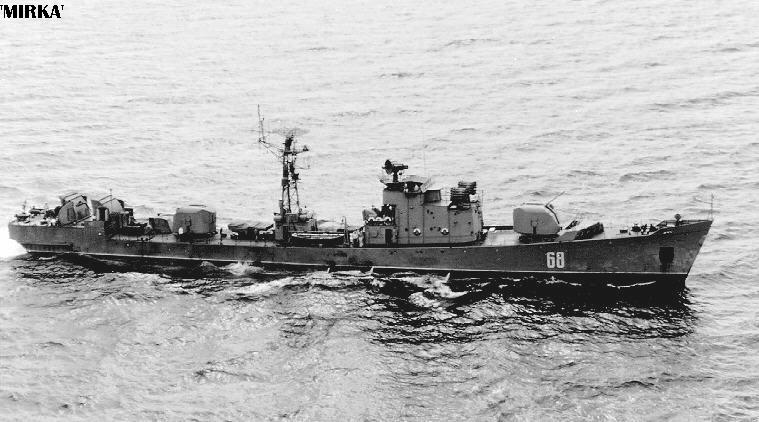
Soviet Frigates: 186
The first class of frigates following the Riga class was the Petya class. The Petya I and Petya II, counted a total of 43 units, the Petya III being an export version (17 built), and two more kept for training. Petya II would later be exported. 8 Petya I, 20 Petya II and the two Petya III were still active in 1990. The next Mirka class counted 18 units, built between 1964 and 1966, with superior ASW capabilities. 13 stayed in service in 1990. But the most formidable Soviet frigates has been the following, those of the Krivak class, a series started in 1971 and completed in 1991 with 34 units.
Although they were more impressive than the previous ones, with triple the displacement and much improved versatility, these units would be split into three subclasses, Krivak I to III, all of which were in service in 1990. In parallel, the Grisha class frigates were substitutes for the export Poti class ASW corvettes, with a mass production of 97 ships, built between 1968 and 1982 (5 subclasses). Lastly, the Soviets put into service in 1986-90 twelve “Parchim” class frigates, built in the GDR. Shipyards also built the Koni class for export, very close to the Grisha but simplified.

Soviet Submarines: 268
Although these numbers are impressive, the bulk was made of standard diesel-electric units of the latest class, not costier SSN and SSGNs that ate most of the budget. By the 1960s, the Soviet fleet already had the first fleet of submarines in the world. It was going to start its first SSN (November) and SSBN (Golf) rapidly in order to constitute the first fleet of nuclear submarines in the world, With a potential for striking US task-force. The November were built between 1959 and 1963. These 15 units were the first propelled by this energy, clearly “wiped plaster” in the matter, painfully clearing the path for the units following. This class had a high rate of loss:
Before 1990, 5 units had severe reactor damage, of which 4 were lost. From 8 to 10 still had to be on active duty. Shortly after the release of the November, the Echo, missile-launching SNAs entered service with a reactor less efficient but also less complex. These first six units were singled out by their lateral ramps. The latter were removed and these vessels subsequently served as pure SNAs. After accidents, only three remained in 1990. The larger Echo IIs, 29 (1962-66), retained their missiles, and 17 remained in service in 1990. There were four casualties Reactor damage.

The first strategic submarines will be classically powered: These were the 24 “Golf”, based on the “Foxtrot” hull, which were reliable enough to test the first silos ballistic missiles mounted in the kiosk, A Russian originality. They will be followed by the 8 “Hotel”, the first real SNLE established on the modified hull of November and carrying three silos of kiosk. As a result of the SALT I disarmament agreements, they were inactivated in this role in 1990. It was actually the Yankees who took up the torch. These units are comparable to what was done to the west, with 16 silos mounted in the hull. Their reactor is also more reliable. 34 units were launched between 1966 and 1972.
Following the same bilateral disarmament agreements, they were partially inactivated, so that in 1990 only 12 units were retained in this role, the others placed in reserve or assigned to other units roles. The Delta class that followed this series will be divided into four additional classes between 1972 and 1992. The Delta I, II and III varied little in size, unlike the last Delta IV (1985-92), the largest of all. The Typhoon, released in 1980, inaugurated earlier a new series capable of carrying 20 multi-warhead SSN-20 intercontinental missiles (up to 20), but also being able to remain hidden under the polar ice for more than one Year before hitting.
Conventional Soviet submarines has been in force since the 1950s, but were still produced until 1990. The Foxtrot class units, were large oceanic types built between 1961 and 1981, in a large class of 62 ships and 12 more for export. All were in service in 1990, as 19 “Romeo”, more modern (1972-81).
Their successors are the “Kilo”, 25 units launched before 1990, some exported. It should be noted that the Soviet Navy also experimented with conventional submarines launching anti-ship missiles, the “Juliett” SSGs, and their four lateral ramps identical to those of the nuclear-powered “Echo”. 16 units were launched between 1960 and 1968, of which 12 units remained in service in 1990.
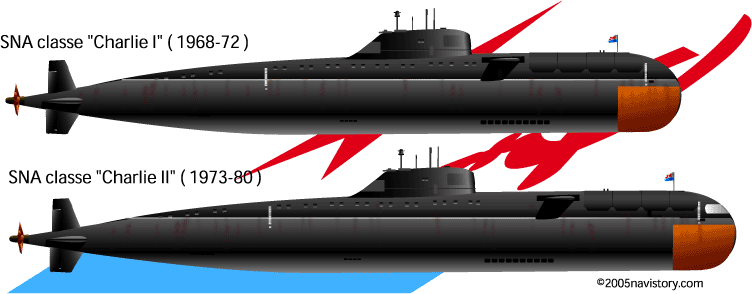
Missile launchers continued to be developed, these were the “Charlie”, supposed to succeed the Echo. The Charlie I (1968-73, 12 units) were followed by the Charlie II (1973-80, 6 units), armed with anti-ship missiles in silos. The prototype ‘Papa’ (1969) announced the Oscar of the next generation. These will be the most powerful SNAs in service in the world. With their 15 to 16,000 tons dives and 24 missiles in quadruple lateral ramps, they have an unusual width (18.2 m) for submarines of this class. The two Oscar I class (1980-82) were followed by the 8 Oscar II (1987-93). The Kursk of the Oscar II class made himself sadly famous for his tragic and recent shipwreck. After the November, unreliable, the “Victor” was developed, supposed to replace it from 1967.

There were 15 Victor I, 7 Victor II and 26 Victor III, the latter entering service between 1978 and 1992. These relatively conventional SSNs were supported by the revolutionary Alfa class, very fast, with 7 ships delivered between 1972 and 1983. The “Sierra” class returned to more conventional reactors, but announced the future generation giving priority to hunting cavitation. The Sierra were 2, built between 1984 and 1990. They announced the new generation of Soviet SNA, currently the latest, the series “Akula”. 16 units are currently in service, 8 in 1990, as well as the “Mike” and “Severodvinsk” prototypes. Other research units were launched, unique prototypes like Beluga, Lima, AS12, Paltus, X-Ray, and series like the two Uniform, the two India and the four Bravo.
Soviet Corvettes: 171
These units were used for escorting, submarine hunting and subsidiary tasks. First of all were the Poti class ships, 68 ships built between 1961 and 1968, of which 63 were in service by 1990. Very fast, these vessels were the first to have a gas turbine. They will be supported by the Nanuchka class, with very stocky characteristics of big stars, and still very well armed. These 35 units (1975-81) were in service in 1990 in four subclasses (one of which was unaccounted for and one counted as one building).

The Tarantul which followed were of the same model, and were built between 1981 and 1993 at the level of 65 Tarentul I and 23 Tarentul II, but only the latter were integrated into the fleet, the others being reserved for export. Two Tarentul I served, however, for training. In 1990, there was 25 Tarentul in service. The Pauk class corvettes, built on the same expanded hull, served as ASM patrol vessels. 45 were built from 1978 to 1983. 8 were later transferred to friendly countries, but 43 were available in 1990. Similarly, 35 ASM Coast Guard patrol boats were constructed by KGB men, the “Svetlyak” , From 1989 to 1995, but it seems that the series continued. About 3 or 4 were finished in 1990. The “Dergach”, are large missile launcher corvettes, the first unit of which dates from 1987 and the other from 1991.
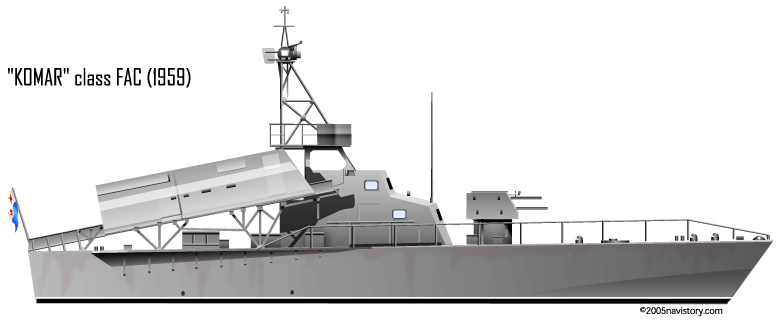
Author’s illustration of the Komar type.
Soviet MTBs and hydrofoils: 326
In this respect, it is indisputable that the USSR was one of the most aggressive naval forces, like the German S-Boote fleets. It started with the Komar, 112 units from the 1960s were the first units of its kind in the world. 35 were in service in 1990. The Chinese built 50 under license and 85 derivatives (Hoku class), as were the North Koreans (So Hung class), the Egyptians (class 6 October). Their successors, the stars of class Osa, were larger and carried four missiles instead of 2. To the total, 289 were built between 1960 and 1970.
This model was a great success for export, the Chinese building it under (Huangfen) as well as the North Koreans (Soju). As a result of numerous transfers, the Osa I and II remaining in service in 1990 were 46. A modified ASM version, the Stenka class, appeared shortly thereafter and was built on 114 ships between 1967 and 1971, 7 of which were transferred to Cuba and In Kamputchea in 1985.
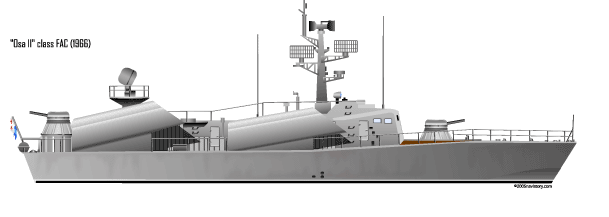
Author’s illustration of the Osa type.
In 1990, 107 Stenka type were still in service, used as coastguard. A hydrofoil variant of the Osa was constructed experimentally, the Slepen class (2 units, 1970 and 1975). There were also the class of Shershen torpedo boats, with 123 units that will be born between 1967 and 1970, the major part of which was later transferred to friendly countries. 42 in service in 1990. The “Mol” was a simplified version of the Shershen, for export, 36 units built and only one conserved for training under Russian flag in the Black Sea.
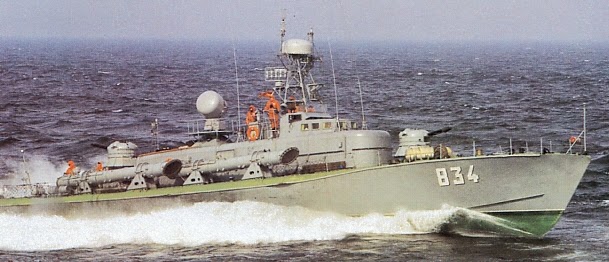
Shershen class (cc)
The hydrofoils deployed by the Soviet navy were derived from the “Osa”, the Turya class, armed with cannons (30 units, 1972-76), but after transfers, 10 in service under the Russian flag. The missile-armed variant was called Matka, and was produced on the basis of 16 ships between 1977 and 1983, all in service in 1990. There were also the coast-guard hydrofoils of the Pchela class (18 units, 1964-65) Used by the KGB, and three others more or less experimental, the unique “Babochka” and the two “Mukha” specialized in the fight ASM. The Sarancha (1977) was another prototype equipped with a silo missile, too heavy and complex to produce in series. The Muraveys will be 16 units (1983-89) of coast guard hydrofoils used by the KGB, they will be the last of this type.
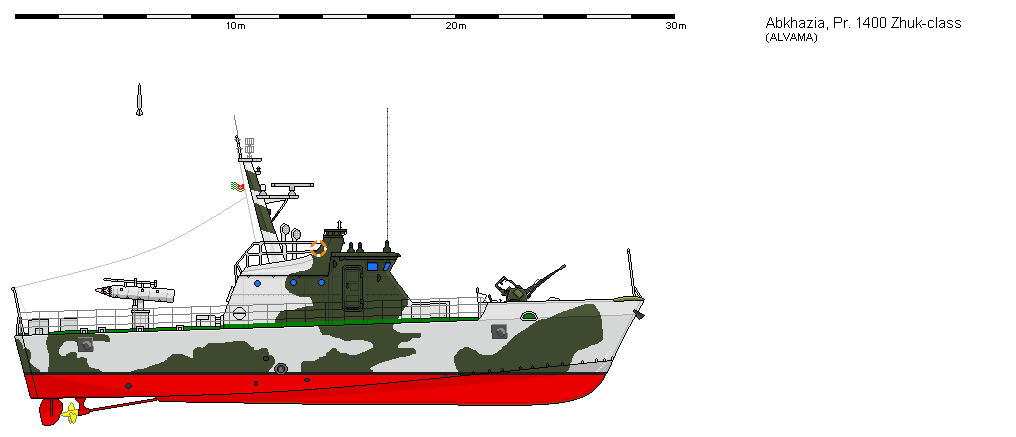
Zhuk class on shipbucket by ALVAMA
Soviet Patrollers and monitors: 182
To take over from the large Kronstadt dating back to 1948, and retired from service before 1990, the Russians began to construct between 1956 and 1966 124 smaller patrollers, the SOI class, of whom fewer than 35 were still in service in 1982. They were Retired from service before 1990. The KGB also received 34 small coastal patrol vessels of the “Poluchat” class in 1955-56, but they were all transferred to the friendly country and the others removed from service before 1990.
The Zhuk were even smaller (50 tons) and Replacing the former, were built from 1971 to 1986 at the rate of 85, of which 7 were after transfers under Russian colors in 1990. The Soviets also operated a number of riverine gunboats, first BK 166 (1947-52, 119 units, all reformed), then the Shmel, river monitors (119 units from 1967 to 1974), in service in 1990; The Vosk, also river monitors (1980-84, 7 units), the Piyavka patrol vessels (8 units on the hull of the Vosh), and 20 light stars Sagyak (1986).
Soviet minesweepers: 203
Most ancient were the class T58, 78 of which extant in 1962. They were subsequently converted to other roles. The Yurka which followed in 1962-69 (41 ships) and Natya (1963-67, 45 ships), were of the same enlarged and improved type. 22 were transferred, and it appears that 64 ships were still in service in 1990, subsequently reformed from 1994 onwards. The much larger Gorya were two mine-hunters (1987). There were also a serie of coastal minesweepers class Sasha (37 from 1960 to 1968, but no more than ten are still in service in 1990).
Official figures: two in service in 1992. The Vanya (47 units 1960-73), about which 40 in service in 1990 were also coastal minesweepers. Three Zhenya were also built in 1969, 72 Sonya class (1971-91) and 45 Yevgenya class (1967-76), all lightweight minesweepers, replacing the TR40 series (55 built in Poland 1956-58, deleted), and 130 K8 (1954-59 by the same manufacturer). The Yevgenya serie continued after 1976, but only for export. 58 Sonya and 10 Yevgenya were extant in 1990, supported by 5 Olya (1975). Two Andryusha prototypes were also built in 1975, and 10 Ilyusha series were built in 1966. There were also three Alesha class minelayers (1967).
Soviet Amphibious fleet: 249
Second in the world, with a dozen specialized ships classes possibly supported by two Moskva helicopter carriers and the four Kiev. Landing craft were of the MP2, MP4, MP6, MP8 series (23, 10, 8 and 19 units 1956-62). These vessels were removed from service before 1990. MP10 series consisted of about 40 units, constructed in 1959-62, all removed from service before 1982. They were joined by the improved SMB-1 (1960-63), Thirty built and fifteen in service in 1990. The Vydra of 1967-69 (fifty-six), were built in East Germany. Many has been resold, 9 still in service in 1990.
Equivalents of the US LCUs of the last war (landing craft utilities), They were replaced by much faster hovercrafts. Small landing units (LCIs) were built in mass in the years 1954-73: These are several hundred “T4”, all transferred and the last removed from service before 1990. The last of the second series (85 units) saw 10 of their own still active on the fleet lists in 1990. Ondatra was their replacement version, but only 49 were produced from 1979 to 1983. 40 in service in 1990.
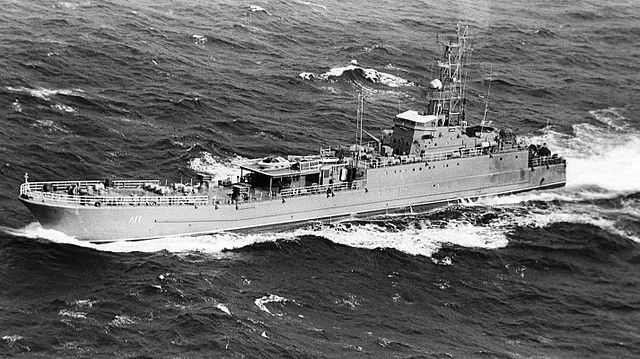
The bulk of the landing force consists of Polocny class vessels, medium (770-1150 tons, 180 to 250 tons of military cargo). 51 ships built in poland in 1961-73, 19 transferred to friendly countries in the years 70-80. 30 in service in 1990. They are heavily armed. The large modern LST are the “Ropucha” (3,200 tons), also built in Poland, in Gdansk. Heavily armed, capacity 450 tons of freight, equipment and troops (230 men). But they only reach 75% of the large contemporary American LST. 28 units built from 1970 to 1978, including three Ropucha II, 25 in service in 1990.
The first LST constructed in the USSR (Kaliningrad), are the “Alligators”. These large ships (4700 tons), armed with missiles, rocket launchers and DCA, will be launched between 1962 and 1967 at the rate of 13 units, capable of carrying 25 to 30 tanks or 1500 tons of equipment. They were in service in 1990, but stripped of lists since. The biggest landing ships in the Soviet fleet are the famous Ivan Rogov (3 ships, launched in 1978, 82, 89), measuring 13,000 tons at full load.
They are also in service in 1990. They carry a full battalion with 10 T72 tanks and 30 light vehicles, and can activate 4 assault helicopters (Mi-8 and / or Mi-24) although their normal allocation is 4 Ka-25 Hormone or Ka-32 Helix for the ASM patrol, and two hovercrafts of the Lebed class.
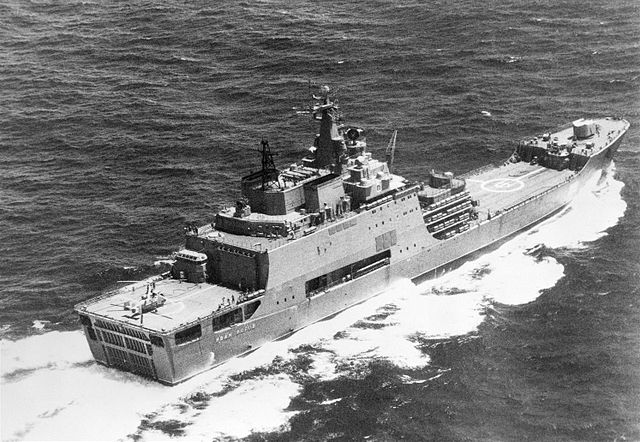
Ivan Rogov class assault ships (cc)
One of the originalities of the Soviet amphibious fleet is many assault hovercrafts employment. These vessels have two distinct advantages compared to their conventional equivalents, barges or barges: They are very fast (55-75 knots), capable of approaching deep on the mainland, but on the other hand have the enormous inconvenience of a record consumption , And therefore limited autonomy. There are two classes of large autonomous units, the Aist (19 ships-1970-85), and Pomornik (13 ships-1987-90).
All of them are in service in 1990. Smaller, the hovercrafts are 5 different classes, the “Gus”, “Lebed”, “Pelikan”, “Tsaplya”, and “Utenok” (40,20,3,8,2 ). The Pelikans are Lebed specialists in electronic countermeasures, the Tsaplya are river hovercrafts. All but two ‘Gus’ were in service in 1990.
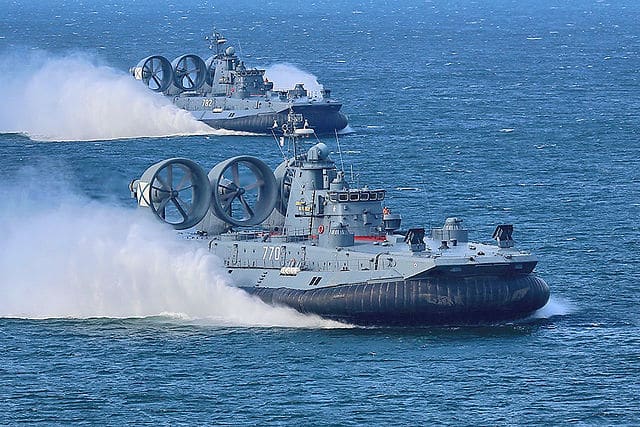
Pomornik class assault hovercrafts (cc)
The other originality of the Soviet fleet was its use of ground-effect gears, the famous “ekranoplanes”, the prototype of which was the enormous Spasatel, the “caspian monster,” as the NATO. Three prototypes were constructed to evaluate the possibilities of these devices (see sheet). The only operational classes were “Lun” (3 units, anti-ship missile launchers), and Orlan (5 units, for disembarkation).
These vessels were withdrawn from service after 1990 because of their recurring problems of corrosion (sea water is formidable for the structure of these hybrids, closer to aircraft than for ships), and lack of radius of action Too low, as well as limited carrying capacity.
Soviet Naval Aviation: (See file)
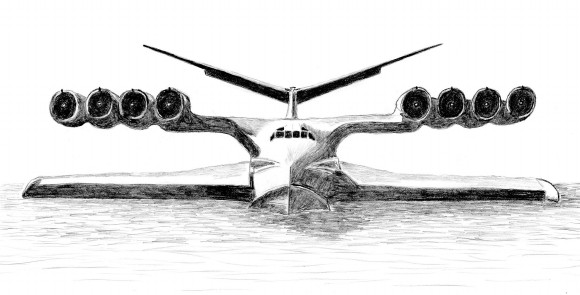
The Ekranoplane KM, or “Caspian monster”, most amazing craft used by the Soviet Navy so far
It had several hundred aircraft, including long-range bombers, such as the Tu-22 “Backfire”. There were Sukhoi Su-27K and Su-33 “Flanker” (25 aircraft) fighter-bombers, never fully operational on the Kuznetsov; 60 Su-25 ‘medium fighter bombers Su-25’ Frogfoot ‘(idem), 65 medium bombers Su-24’ fencer-D ‘, 30 medium bombers Tupolev Tu-16’ Badger ‘(approaching retirement), 20 heavy bombers Tu 130 Tu-22M ‘Backfire’, 75 Tu-95/142 “Bear”, turboprop, equivalent to the B-52 but specializing in ASM and anti-ship, 80 seaplanes Beriev Be-12 “mail (ASM, reconnaissance and rescue), 45 ASL Lliouchine LL-38 “May” patrollers, as well as embarked helicopters, 65 Kamov Ka-25 Hormones, 170 Ka-27/32 “Helix” That 105 Mil Mi-14 Haze A/B.
The Warsaw pact Navies
When NATO was signed in 1949 Stalin took note, but decided to set up a similar organization. After he passed out and the accession of Nikita Khrushchev, West Germany ratified in turn a treaty, “in the process of re-militarization”. Faced with the fait accompli, the leader of the Kremlin endeavoured to set up an organization of the same type. The Warsaw Pact was signed on 14 May 1955 between the countries of the Communist block in Europe (China was excluded). In addition to the “Big Brother”, the USSR, Poland, Czechoslovakia, Hungary, Bulgaria, Albania, Romania and the GDR included Poland.
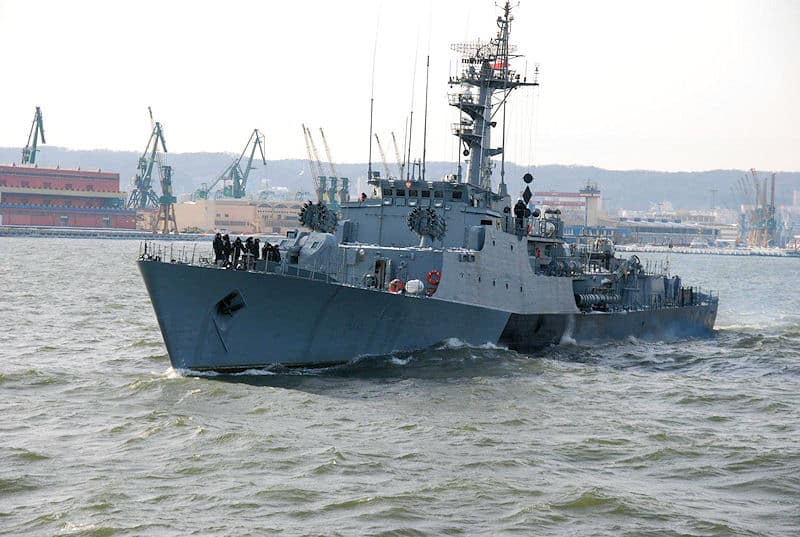
Polish Kaszub class corvette
This text of 11 articles stipulated that the adherence of new members could only be done with the consent of the other 9 members. Yugoslavia of the time, under the aegis of Tito, remained neutral. The command of the forces of these countries passed into a single structure, at that time headed by General Koniev. The naval forces of these countries were at the same time under a single (Soviet) command, and the naval policies were regulated according to the needs of the community. The GDR, for example, was rapidly specialized in the war of the mines.
Each country sent a representative to the annual ordinary meeting. This pact enshrined the Soviets’ control of Eastern Europe. When Hungary attempted to become neutral in 1956, the insurrection was crushed and the government overthrown and replaced in two weeks. Later, USSR did the same in the spring of Prague in 1968.
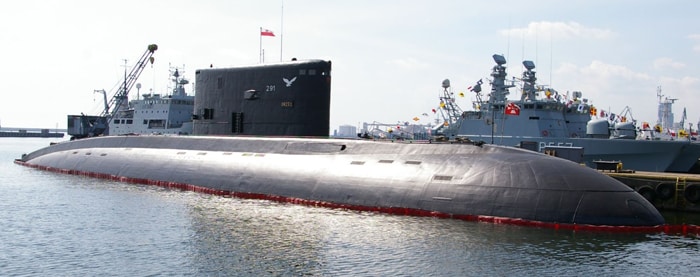
“Improved kilo” polish class attack submarine
This intransigence also caused the withdrawal of Albania, which was not worried because of its geographical isolation among neutral nations. In 1968, therefore, Albania will withdraw, and China, present from the beginning as a mere observer, will also retire in 1962. In 1985, it was decided to renew it for a period Of 20 years. It ended in 1991 following the fall of the wall and the dissolution of the Soviet sphere, officially announced in June in Prague.
Subsequently, in 1999, three countries of this former alliance entered NATO: Poland, Hungary, and the Czech Republic. Poland sent troops during the invasion of Iraq and supported the position of the countries ranked alongside the United States within NATO.
On the navy side, the massive disparity of size between the Soviet Navy and the one of its partners, often landlock or with limited access, naturally favoured a specialized approach inside a global naval strategy. Nations of the warsaw Pact that had a sizeable navy were Poland, RDA, both facing the Baltic, Romania and Bulgaria, in the Black sea, Albania and Yugoslavia for the Adriatic. The East German navy ranked first in the 1980s, in size and numbers of ships, and specialized in sub-chasing and minesweeping, but there were also numerous coastal attack crafts in backup. Both East Germany and Poland had submarines, corvettes and amphibious assault ships for combined assaults.
Romania and Yugoslavia on the other hand had more autonomy in their choice. Romanian could venture into more massive shipbuilding, producing the impressive Muntenia missile destroyer, while Yugoslavia relied on an old destroyer design and a handful of corvettes and submarines in addition to small crafts. All combined could not approach the size of the West German, even the Netherlands navy, and Western Europe as a whole combined a naval power large enough to cope with the USSR at some point without the assistance of the US Navy, it could deal with ease with the Warsaw pact in any case.
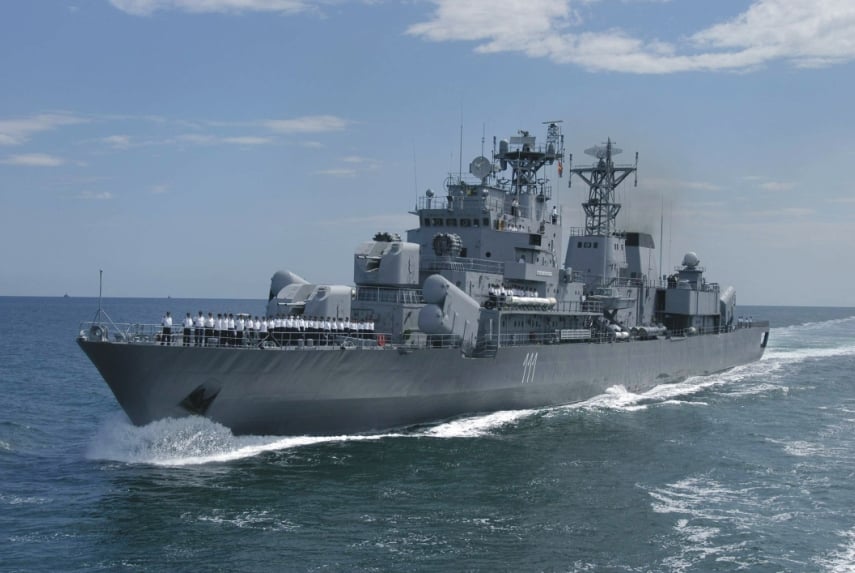
Mărășești, large Romanian missile frigate (ex-Muntenia)
Links/Sources
An excellent infographic depicting the differences between the Soviet and Russians navies
www.warboats.org/
https://russianships.info
navis_guerrefroide.net
Soviet Navy (wikipedia)
https://www.globalsecurity.org
Cold war soviet navy vs modern Russian navy
https://www.realcleardefense.com/


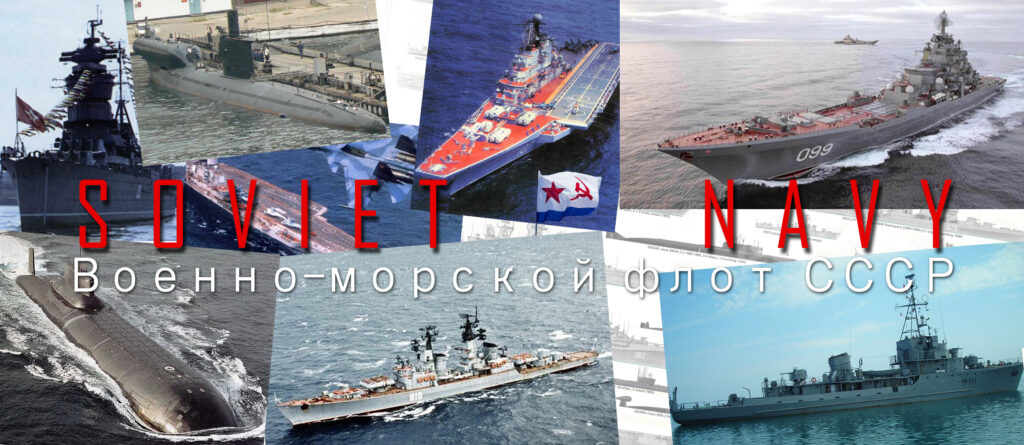
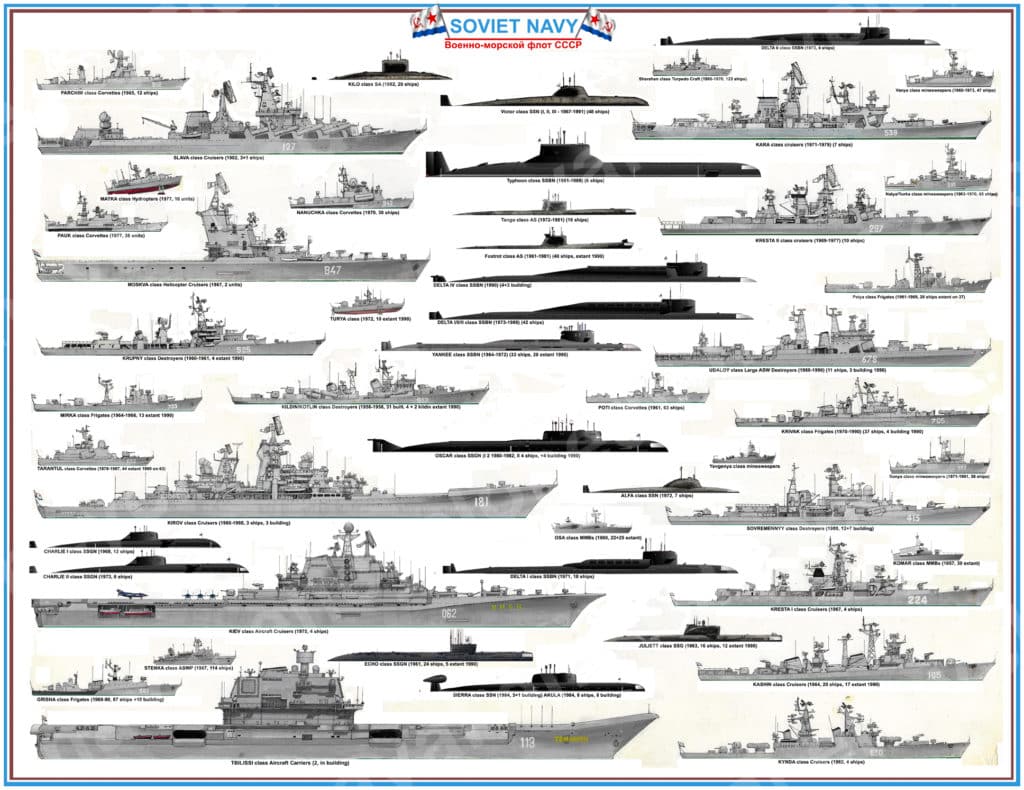
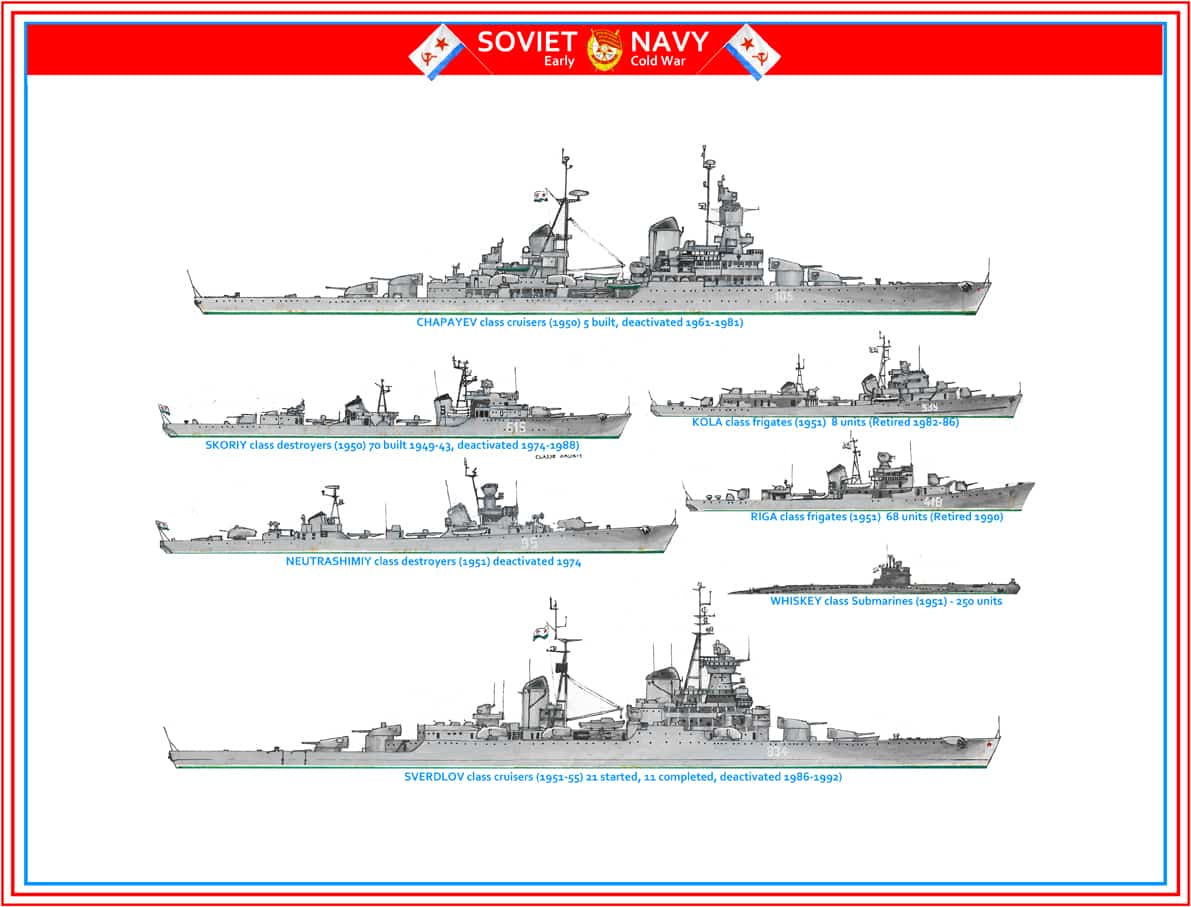
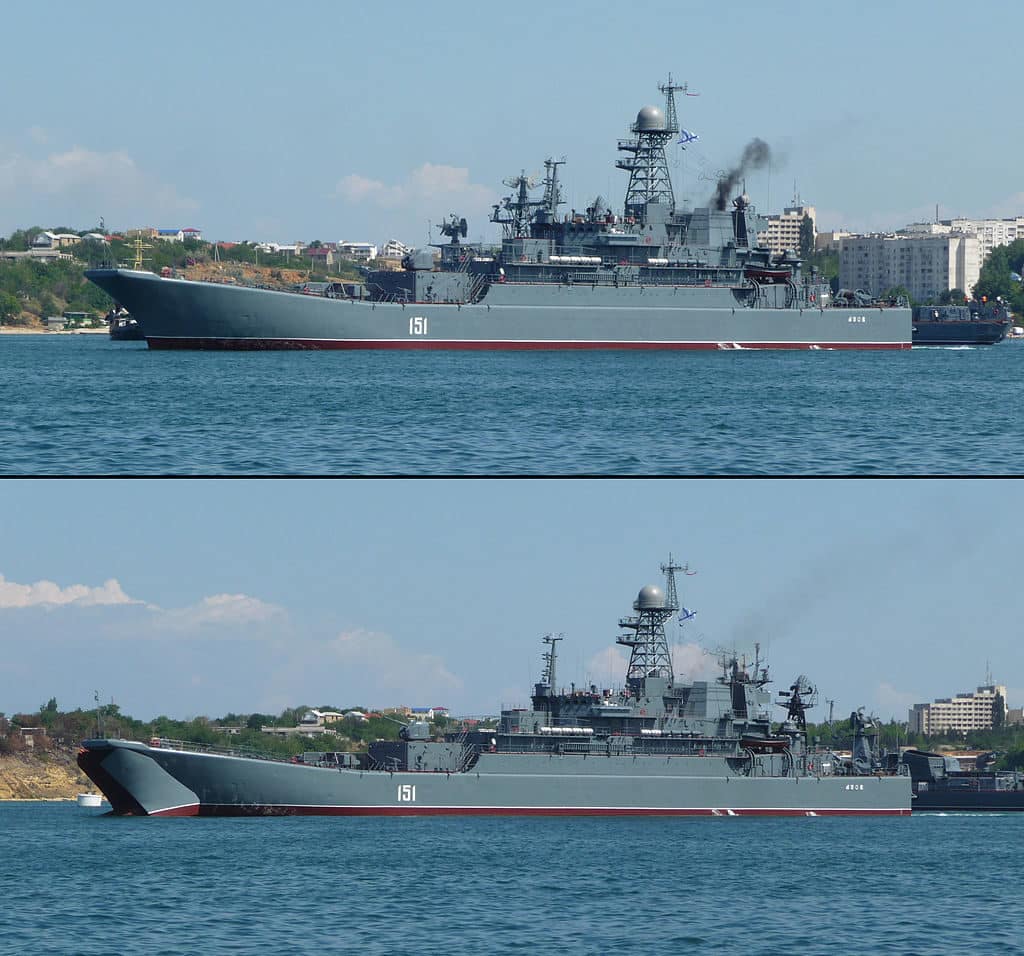
 Latest Facebook Entry -
Latest Facebook Entry -  X(Tweeter) Naval Encyclopedia's deck archive
X(Tweeter) Naval Encyclopedia's deck archive Instagram (@navalencyc)
Instagram (@navalencyc)





 French Navy
French Navy Royal Navy
Royal Navy Russian Navy
Russian Navy Armada Espanola
Armada Espanola Austrian Navy
Austrian Navy K.u.K. Kriegsmarine
K.u.K. Kriegsmarine Dansk Marine
Dansk Marine Nautiko Hellenon
Nautiko Hellenon Koninklije Marine 1870
Koninklije Marine 1870 Marinha do Brasil
Marinha do Brasil Osmanlı Donanması
Osmanlı Donanması Marina Do Peru
Marina Do Peru Marinha do Portugal
Marinha do Portugal Regia Marina 1870
Regia Marina 1870 Nihhon Kaigun 1870
Nihhon Kaigun 1870 Preußische Marine 1870
Preußische Marine 1870 Russkiy Flot 1870
Russkiy Flot 1870 Svenska marinen
Svenska marinen Søværnet
Søværnet Union Navy
Union Navy Confederate Navy
Confederate Navy Armada de Argentina
Armada de Argentina Imperial Chinese Navy
Imperial Chinese Navy Marinha do Portugal
Marinha do Portugal Mexico
Mexico Kaiserliche Marine
Kaiserliche Marine 1898 US Navy
1898 US Navy Sovietskiy Flot
Sovietskiy Flot Royal Canadian Navy
Royal Canadian Navy Royal Australian Navy
Royal Australian Navy RNZN Fleet
RNZN Fleet Chinese Navy 1937
Chinese Navy 1937 Kriegsmarine
Kriegsmarine Chilean Navy
Chilean Navy Danish Navy
Danish Navy Finnish Navy
Finnish Navy Hellenic Navy
Hellenic Navy Polish Navy
Polish Navy Romanian Navy
Romanian Navy Turkish Navy
Turkish Navy Royal Yugoslav Navy
Royal Yugoslav Navy Royal Thai Navy
Royal Thai Navy Minor Navies
Minor Navies Albania
Albania Austria
Austria Belgium
Belgium Columbia
Columbia Costa Rica
Costa Rica Cuba
Cuba Czechoslovakia
Czechoslovakia Dominican Republic
Dominican Republic Haiti
Haiti Hungary
Hungary Honduras
Honduras Estonia
Estonia Iceland
Iceland Eire
Eire Equador
Equador Iran
Iran Iraq
Iraq Latvia
Latvia Liberia
Liberia Lithuania
Lithuania Mandchukuo
Mandchukuo Morocco
Morocco Nicaragua
Nicaragua Persia
Persia San Salvador
San Salvador Sarawak
Sarawak Uruguay
Uruguay Venezuela
Venezuela Zanzibar
Zanzibar Warsaw Pact Navies
Warsaw Pact Navies Bulgaria
Bulgaria Hungary
Hungary

 Bundesmarine
Bundesmarine Dutch Navy
Dutch Navy Hellenic Navy
Hellenic Navy Marina Militare
Marina Militare Yugoslav Navy
Yugoslav Navy Chinese Navy
Chinese Navy Indian Navy
Indian Navy Indonesian Navy
Indonesian Navy JMSDF
JMSDF North Korean Navy
North Korean Navy Pakistani Navy
Pakistani Navy Philippines Navy
Philippines Navy ROKN
ROKN Rep. of Singapore Navy
Rep. of Singapore Navy Taiwanese Navy
Taiwanese Navy IDF Navy
IDF Navy Saudi Navy
Saudi Navy Royal New Zealand Navy
Royal New Zealand Navy Egyptian Navy
Egyptian Navy South African Navy
South African Navy






























 Ukrainian Navy
Ukrainian Navy dbodesign
dbodesign